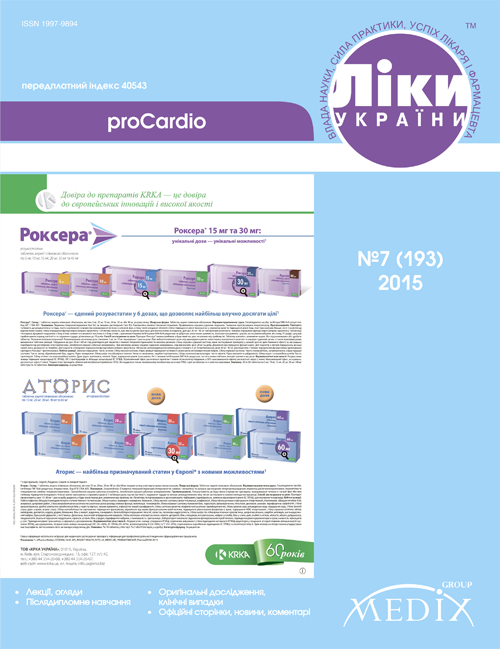Повторна стенокардія після реваскуляризації міокарда: механізми, діагностика, медикаментозна терапія. Частина 2
DOI:
https://doi.org/10.37987/1997-9894.2015.7(193).222617Ключові слова:
повторна стенокардія, стентування коронарних артерій, івабрадин, ранолазин, нікорандилАнотація
Повторна стенокардія у пацієнтів, які перенесли черезшкірне коронарне втручання (ЧКВ), визначається як рецидив болю або дискомфорту в грудній клітці. Ретельну оцінку рекомендують проводити для визначення несерцевих і серцевих причин. Останні можуть бути пов’язані зі структурними змінами («stretch pain», рестеноз стента, тромбоз стента, неповна реваскуляризація, прогресування коронарного атеросклерозу) або функціональними (мікроваскулярна дисфункція, коронарний спазм). Діагностичний алгоритм включає проведення електрокардіографічних (ЕКГ) навантажувальних тестів, магнітно-резонансної томографії (МРТ) та комп’ютерної томографії (КТ) серця або інвазивну оцінку коронарного кровотоку за допомогою фракційного резерву кровоплину ‒ ФРК (FFR ‒ fractional flow reserve), коронарного резерву кровоплину ‒ КРК (CFR ‒ intracoronary flow reserve) та проби для провокації коронарного спазму. Якщо повторна реваскуляризація не показана ‒ терапевтичні підходи мають бути спрямовані на основні механізми виникнення повторної стенокардії шляхом застосування різних препаратів, таких як блокатори β-адренорецепторів, блокатори кальцієвих каналів, івабрадин, ранолазин чи нікорандил.
Посилання
Fox K., Garcia M.A., Ardissino D. et al.; Task Force on the Management of Stable Angina Pectoris of the European Society of Cardiology; ESC Committee for Practice Guidelines (CPG). Guidelines on the management of stable angina pectoris: executive summary: The Task Force on the Management of Stable Angina Pectoris of the European Society of Cardiology // Eur. Heart J. – 2006. – Vol. 27. – P. 1341–1381.
Fraker T.D., Fihn S.D. Chronic angina focused update of the ACC/AHA 2002 guidelines for the management of patients with chronic stable angina // Circulation. – 2007. – Vol. 116. – P. 20762–20772.
Nissen S.E., Nicholls S.J., Sipahi I. et al.; for the ASTEROID Investigators. Effect of very high-intensity statin therapy on regression of coronary atherosclerosis. The ASTEROID trial // JAMA. – 2006. – Vol. 295. – P. 1556–1565.
Fox K., Ford I., Steg P.G. et al.; on behalf of the BEAUTIFUL investigators. Relationship between ivabradine treatment and cardiovascular outcomes in patients with stable coronary artery disease and left ventricular systolic dysfunction with limiting angina: A subgroup analysis of the randomized, controlled BEAUTIFUL trial // Eur. Heart J. – 2009. – Vol. 30. – P. 2337–2345.
Tardif J.C., Ponikowski P., Kahan T. ASSOCIATE study investigators. Efficacy of the If current inhibitor ivabradine in patients with chronic stable angina receiving beta blocker therapy: A 4 month, randomized, placebo-controlled trial // Eur. Heart J. – 2009. – Vol. 30. – P. 540–548.
Köster R., Kaehler J., Meinertz T.; REDUCTION Study Group. Treatment of stable angina pectoris by ivabradine in every day practice: The REDUCTION study // Am. Heart J. – 2009. – Vol. 158. – P. e51–e57.
Shah B.R., Cowper P.A., O'Brien S.M. et al. Patterns of cardiac stress testing after revascular-ization in community practice //J. Am. Coll. Cardiol. – 2010. – Vol. 56. – P. 1328–1334.
Holubkov R., Laskey W.K., Haviland A. et al.; NHLBI Dynamic Registry. Registry Investigators. Angina one year after percutaneous coronary intervention: A report from the NHLBI Dynamic Registry // Am. Heart J. – 2002. – Vol. 144. – P. 826–833.
Serruys P.W., Unger F., Sousa J.E. et al.; Arterial Revascularization Therapies Study Group. Comparison of coronary-artery bypass surgery and stenting for the treatment of multivessel disease // N. Engl. J. Med. – 2001. – Vol. 344. – P. 1117–1124.
Eisenberg M.J., Okrainec K., Lefkovits J. et al.; for the ROSETTA Investigators. Medical therapy in patients under¬going percutaneous coronary intervention: Results from the ROSETTA registry // Can. J. Cardiol. – 2003. – Vol. 19. – P. 1009–1015.
Jeremias A., Kutscher S., Haude M. et al. Nonischemic chest pain induced by coronary interventions: A prospective study comparing coronary angioplasty and stent implantation // Circulation. – 1998. – Vol. 98. – P. 2656–2658.
Joelson J.M., Most A.S., Williams D.O. Angiographic findings when chest pain recurs after successful percutaneous translu¬minal coronary angioplasty // Am. J. Cardiol. – 1987. – Vol. 60. – P.792–795.
Abrams J. Chronic stable angina // N. Engl. J. Med. – 2005. – Vol. 352. – P. 2524–2552.
Al Suwaidi J., Holmes D.R., Salam A.M. et al. Impact of coro¬nary artery stents on mortality and non-fatal myocardial infarction: Meta-analysis of randomized trial comparing a strategy of routine stenting with that of balloon angioplasty // Am. Heart J. – 2004. – Vol. 147. – P. 815–822.
Indolfi C., Pavia M., Angelillo I.F. Drug-eluting stents versus bare metal stents in percutaneous coronary interventions (a meta-analysis) // Am. J. Cardiol. – 2005. – Vol. 95. – P.1146–1152.
Holmes D.R. Jr. In-stent restenosis // Rev. Cardiovasc. Med. – 2001. – Vol. 2. – P. 115–119.
Corbett S.J., Cosgrave J., Melzi G. et al. Pattern of restenosis after drug-eluting stent implantation: Insights from a con-temporary and comparative analysis of sirolimus and paclitaxel-eluting // Eur. Heart J. – 2006. – Vol. 27. – P. 2330–2337.
Cosgrave J., Melzi G., Biondi-Zoccai G.G.L. et al. Drug-eluting stent restenosis: The pattern predicts the outcome // J. Am. Coll. Cardiol. – 2006. – Vol. 47. – P. 2399–2407.
Moussavian M., Casterella P.J., Teirstein P.S. Restenosis after angioplasty // Curr. Treat. Options Cardiovasc. Med. – 2001. – Vol. 3. – P. 103–113.
Eltchaninoff H., Carlot R., Tron C., et al. Analysis of nonintervention strategy for in-stent restenosis in Pauci- or asymptomatic patients // Am. J. Cardiol. – 2004. – Vol. 93. – P. 1038–1040.
Ong A.T.L., Hoye A., Aoki J. et al. Thirty-day incidence and six-month clinical outcome of thrombotic stent occlusion after bare-metal, sirolimus, or paclitaxel stent implantation // J. Am. Coll. Cardiol. – 2005. – Vol. 45. – P. 947–953.
Kuchulakanti P.K., Chu W.W., Torguson R. et al. Correlates and long-term outcomes of angiographically proven stent thrombosis with sirolimus- and paclitaxel-eluting stents // Circulation. – 2006. – Vol. 113. – P. 1108–1113.
Cutlip D.E., Baim D.S., Ho K.K. et al. Stent thrombosis in the modern era: A pooled analysis of multicenter coronary stent clinical trials // Circulation. – 2001. – Vol. 103. – P. 1967–1971.
Tan K.H., Sulke N., Taub N. et al. Predictors of angiographic findings when chest pain recurs after successful coronary angioplasty // Eur. Heart J. – 1995. – Vol. 16. – P. 1593–1602.
Britten M.B., Zeiher A.M., Schаchinger V. Microvascular dysfunction in angiographically normal or mildly diseased coronary arteries predicts adverse cardiovascular long-term outcome // Coron. Artery Dis. – 2004. – Vol. 15. – P. 259–264.
Bolognese L., Carrabba N., Parodi G. et al. Impact of microvascular dysfunction on left ventricular remodeling and long-term clinical outcome after primary coronary angioplasty for acute myocardial infarction // Circulation. – 2004. – Vol. 109. – P. 1121–1126.
Еl-Tamimi H., Davies G.J., Sritara P. et al. Inappropriate constriction of small coronary vessels as a possible cause of a positive exercise test early after successful coronary angioplasty // Circulation. – 1991. – Vol. 84. – P. 2307–2312.
Katoh D., Mizuno Y., Harada E. et al. High incidence of provoked coronary spasm in the presence of a stent after myocardial infarction: Therapeutic and prognostic implications // Coron. Artery Dis. – 2012. – Vol. 23. – P. 141–145.


